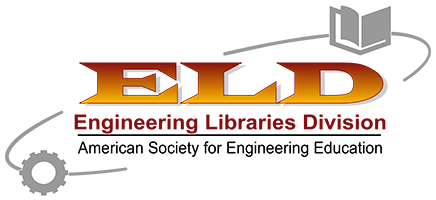ASEE-Engineering Libraries Division:
Information Competency Standards for Engineering
In 2011, members of the ASEE Engineering Libraries Division Executive Committee voted unanimously to adopt the Association of College and Research Libraries, Science and Technology Section’s, Information Literacy Standards for Science and Engineering/Technology*, with an additional standard that addresses the importance of entrepreneurial information skills in engineering.
Members of the ELD Accreditation & Standards Committee also serve on the ACRL STS Task Force on Information Literacy, which is responsible for writing and updating these standards. The following ELD-adopted standards are modified excerpts of the ACRL STS Information Literacy Standards, as they exist today (May 2013). Following each standard is a condensed competency statement that summarizes the lengthier details included in the STS document. Standard Six is a new addition by the Engineering Libraries Division.
- Standard One
- The information-competent student determines the nature and extent of the information needed.
- This competency is demonstrated by the ability to define and articulate the information need, and to prioritize multiple sources of information based on a broad understanding of information sources.
- Standard Two
- The information-competent student acquires needed information effectively and efficiently.
- This competency is demonstrated by the ability to locate and retrieve primary and secondary information as appropriate, utilizing a variety of search strategies and available library services.
- Standard Three
- The information-competent student critically evaluates the procured information and its sources, and as a result, decides whether or not to modify the initial query and/or seek additional sources and whether to develop a new research process.
- This competency is demonstrated by the ability to accurately categorize information found, critically evaluate the information, synthesize it with her/his existing knowledge-base to construct new knowledge, and seek additional information as needed.
- Standard Four
- The information-competent student understands the economic, ethical, legal, and social issues surrounding the use of information and its technologies and either as an individual or as a member of a group, uses information effectively, ethically, and legally to accomplish a specific purpose.
- This competency is demonstrated by the ability to use information legally, understand fair-use guidelines, follow copyright laws, properly attribute sources, and assess one’s own information sources for their adherence to these same principles.
- Standard Five
- The information-competent student understands that information competency is an ongoing process and an important component of lifelong learning and recognizes the need to keep current regarding new developments in his or her field.
- This competency is demonstrated by information behaviors and attitudes that reflect the value of ongoing assimilation, management, and preservation of knowledge, and use of emerging methods and tools for keeping current in a field.
- Standard Six
- The information-competent student identifies sources of information needed to acquire information about established companies in a specific area, and identifies sources of knowledge and skills for entrepreneurial endeavors.
- This competency is demonstrated by the ability to use business, trade, and patent search tools to gather competitive intelligence and understand engineering research and development in a broader strategic and societal context.
*Association of College & Research Libraries, Information Literacy Standards for Science and Engineering/Technology. http://www.ala.org/acrl/standards/infolitscitech
[Accessed June 14, 2013]

